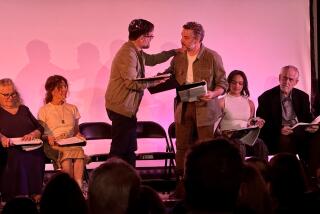Landmark Entering a New Era
Charles Oakley vividly recalls how his heart sank when he surveyed UCLA’s Lawrence Clark Powell Library one dim winter evening after the Northridge earthquake. Workers’ lamps in the attic shone through fissures in the ornate plaster ceiling, casting a web of light against the dark beams.
“It lit up like a city at night with street lights,” said Oakley, the campus architect. “It was then that I realized how much damage there was. I was, quite frankly, devastated.”
Four years after Powell closed its doors for remodeling, the Romanesque-style library--one of the university’s architectural centerpieces and the primary study hall for generations of UCLA students--is quake-repaired, renovated and ready to reopen for the fall quarter.
The concrete had just finished drying on a $35-million seismic strengthening and improvement project, funded by state bonds, when the Jan. 17, 1994, quake struck. The structure stood fast, but the damage to the ceiling and other parts of the building cost the Federal Emergency Management Agency and the state nearly $8 million to repair, and set back the renovation project two years.
After the quake, the mural of richly hued patterns and Renaissance printers’ insignias dangled in brittle pieces from the beams 65 feet above the library floor. “It cracked like an eggshell,” Oakley said.
But when classes begin Sept. 26, students will not only find the 1929 ceiling and its intricate geometrical pattern intact, but will hunker down to study in a library redesigned for new technology and collaborative learning.
Clunky machines that could only perform library searches have been replaced with computers linked to the Internet and other campus databases. A computer “commons area” offers the latest communications software. Group study rooms have been added to the hundreds of individual study carrels. And students can plug their laptop computers into one of 400 desks wired for Internet access.
“I think the students are going to go crazy when they see it,” said Eleanor Mitchell, university librarian. “The irony of it is really interesting: They’ll have an incredible high-tech set-up inside this beautiful, historic packaging.”
Since work began four years ago, students have streamed by the fenced-in library hoping to catch a glimpse of what they’ve heard is the most stunning building on the Westwood campus.
“Every time I saw this place, I said, ‘Damn, I want to see the inside,’ ” said Pek Shojai, a fourth-year history major. “People are generally stoked about it opening . . . it’s got the arches and the architecture, and it really gives you a sense of antiquity, like you’re in an establishment.”
The library, which will officially reopen during a Sept. 24 ceremony, houses 150,000 volumes geared for the undergraduate curriculum. Soft couches, a designated area open until 3 a.m. and more collaborative learning spaces enhance the traditional beauty of the building, Mitchell said.
Sunlight streamed through the arched windows of the main reading room Thursday, when about 400 faculty members and UCLA supporters were given a sneak peek.
“I think it’s spectacular,” said Fred Eiserling, dean of life sciences, as he craned his neck to look at the refurbished ceiling. “When I was in my first year here in the 1950s, all I could remember were dark, dim beams.”
Plaster experts, engineers and FEMA consultants spent about 11 months pondering how to fix the ceiling before they settled on a plan, Oakley said.
The ceiling was removed chunk by chunk. Some pieces were saved, but others were recast and repainted. One result: 65 years of grime was washed away.
Inside the spacious halls, the library’s first visitors in years strolled past Moorish-style pillars embedded with tiles and mosaics, marked with symbols of learning and wisdom. Alumni said seeing the old building evoked reminiscences of their college days, when studying at Powell was often a mask for another intention:
“It was a great place to meet people,” said 1946 graduate Sylvia Thayer with a laughing wink. “There was always a little nook behind every cranny. When I was here, the populace was so small, you could check everybody out.”
More to Read
Sign up for Essential California
The most important California stories and recommendations in your inbox every morning.
You may occasionally receive promotional content from the Los Angeles Times.










